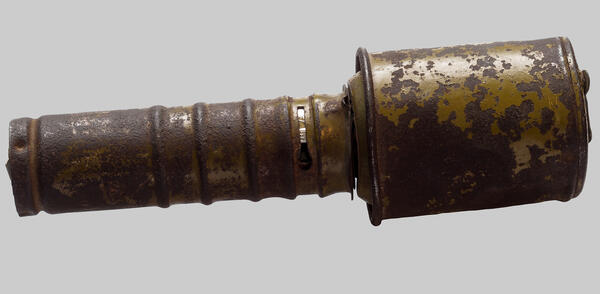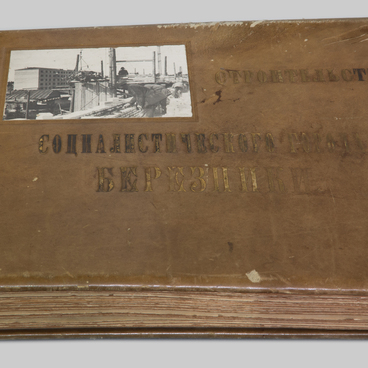During the Great Patriotic War, a lot of plants (more than 10) were evacuated to BereznikI of Molotov Region (today’s Perm Region), namely, 11 chemical plants from Ukraine, Leningrad State Mechanical Plant, Moscow Plant named after V.I. ShkirYAtov and Odessa Metalworking Plant named after Petrovsky. The plant named after PetrOvsky was relocated to BereznikI in August-September 1941. It was a plant classified as a critical for the defense industry.
Since November 1941 the staff of the plant manufactured RGD-33 grenades, since 1943 it launched the production of RGD-42 grenades. The troop trains loaded with captured iron items arrived at the plant, which include German helmets, pieces of armour, and bodies of shells. The captured metal was melted down, and served as the feed for forming and mechanical workshops of the plant where bodies of hand grenades were manufactured.
In addition to the main defense products, the plant, namely, the consumer goods workshop, manufactured brackets to seal mine boxes, small parts for light torches, inserts, gears, and washers. The substandard metal served as the raw material for forks, knives, cans, pots, and watering cans.
By 1943, the plant increased its output 50 times. In October 1943, the All-Union Council of Trade Unions awarded the plant with the II All-Union Prize. During the war years, the plant was staffed with mostly women. There were 98.5% of women who often gained their working qualifications right on the spot in the plant workshops.
DYAkonov 1933 hand grenade - RGD-33 is an offensive-defensive fragmentation grenade. The average weight of the grenade without a fragmentation jacket is 495 grams. The total length of the grenade with the handle was 19.1 centimetres. Technical parameters could vary depending on the manufacturer.
An explosive charge weighing 140 grams was contained inside a cylindrical warhead with a diameter of 52 millimeters, to which a metal handle with a spring and a striker was screwed. Between the warhead and the handle there was an impeller washer that prevented the handle from unscrewing. Inside the warhead, between the outer metal shell and the charge, there were several turns of a steel tape with notches, many fragments were formed from this tape.
There is a socket in the centre of RGD-33 warhead hull. The socket was used to insert a fuse and then to be closed with a special shutter. The design of the shutter is movable in the first samples and rotary in the later ones. The fuse of the grenade contained an explosive composition - detonating mercury.
The grenades were delivered as disassembled to the troops - separately in the boxes were handles with installed firing mechanisms, separately warheads with a charge and separately igniters. When receiving a grenade, the servicemen screwed the handle to the body and put it in a grenade bag. The fuses were kept separately.
Since November 1941 the staff of the plant manufactured RGD-33 grenades, since 1943 it launched the production of RGD-42 grenades. The troop trains loaded with captured iron items arrived at the plant, which include German helmets, pieces of armour, and bodies of shells. The captured metal was melted down, and served as the feed for forming and mechanical workshops of the plant where bodies of hand grenades were manufactured.
In addition to the main defense products, the plant, namely, the consumer goods workshop, manufactured brackets to seal mine boxes, small parts for light torches, inserts, gears, and washers. The substandard metal served as the raw material for forks, knives, cans, pots, and watering cans.
By 1943, the plant increased its output 50 times. In October 1943, the All-Union Council of Trade Unions awarded the plant with the II All-Union Prize. During the war years, the plant was staffed with mostly women. There were 98.5% of women who often gained their working qualifications right on the spot in the plant workshops.
DYAkonov 1933 hand grenade - RGD-33 is an offensive-defensive fragmentation grenade. The average weight of the grenade without a fragmentation jacket is 495 grams. The total length of the grenade with the handle was 19.1 centimetres. Technical parameters could vary depending on the manufacturer.
An explosive charge weighing 140 grams was contained inside a cylindrical warhead with a diameter of 52 millimeters, to which a metal handle with a spring and a striker was screwed. Between the warhead and the handle there was an impeller washer that prevented the handle from unscrewing. Inside the warhead, between the outer metal shell and the charge, there were several turns of a steel tape with notches, many fragments were formed from this tape.
There is a socket in the centre of RGD-33 warhead hull. The socket was used to insert a fuse and then to be closed with a special shutter. The design of the shutter is movable in the first samples and rotary in the later ones. The fuse of the grenade contained an explosive composition - detonating mercury.
The grenades were delivered as disassembled to the troops - separately in the boxes were handles with installed firing mechanisms, separately warheads with a charge and separately igniters. When receiving a grenade, the servicemen screwed the handle to the body and put it in a grenade bag. The fuses were kept separately.



